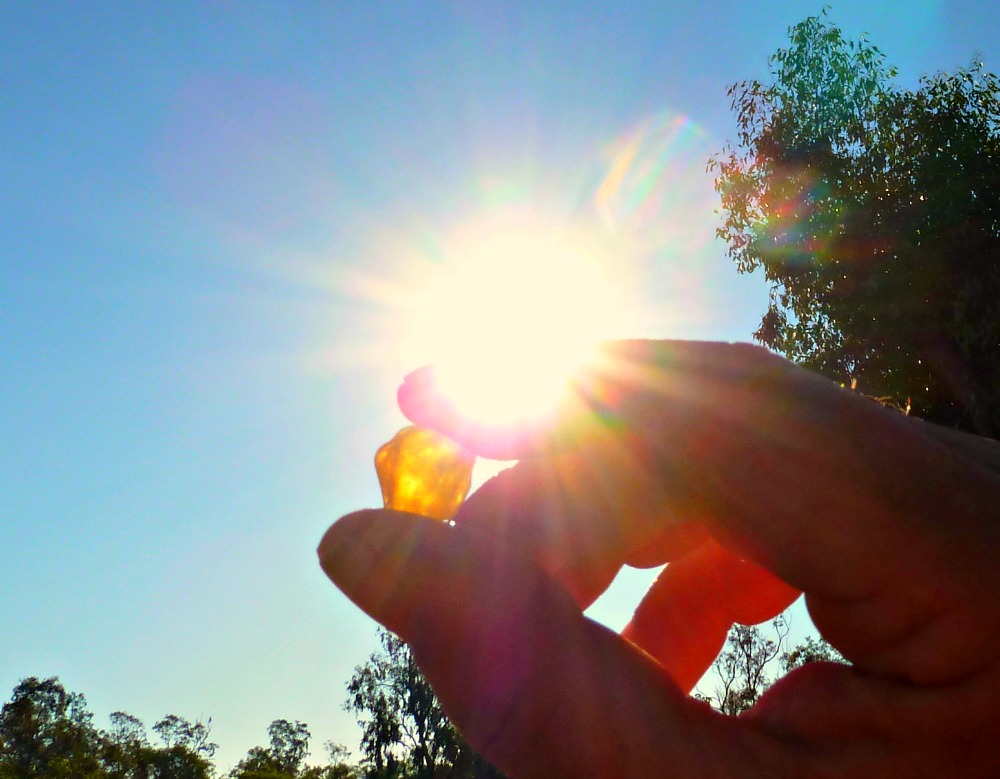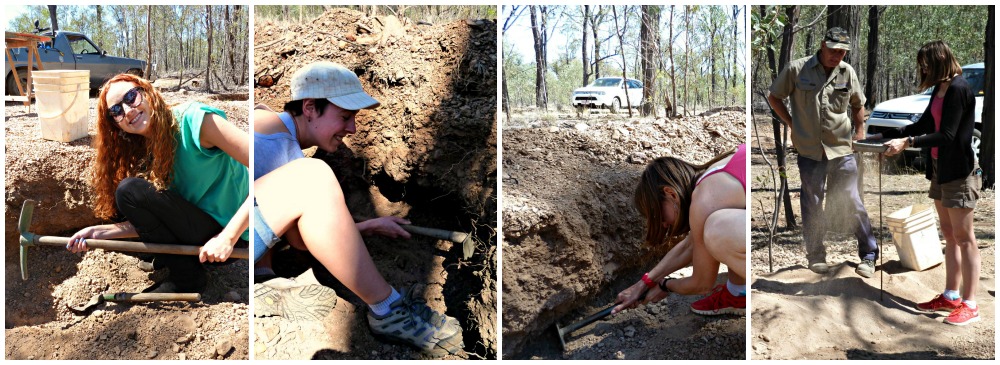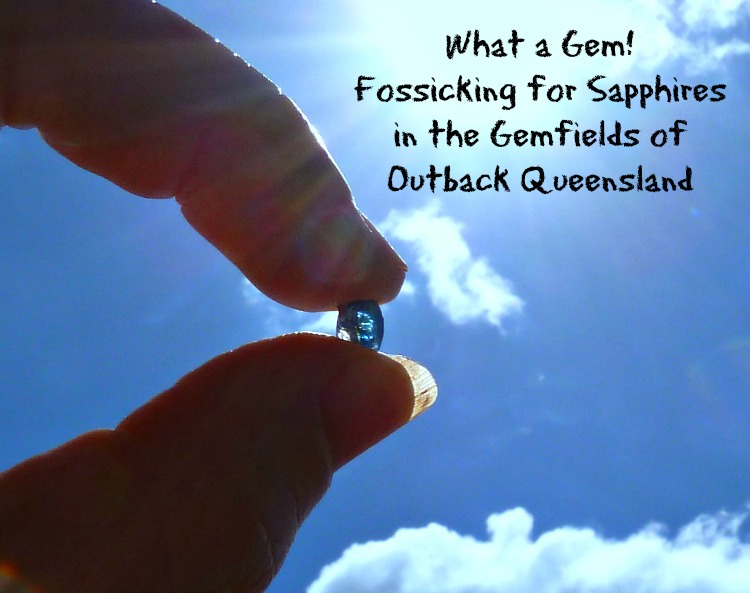“All the buckets had been taken except for one” John recounted.
“‘Lucky Last’ I called it” and his eyes crinkled up and his cheeks reddened as he chuckled to himself.
Having paid the princely sum of $8 for a bucket of wash, (many places here in the gemfields of central outback Queensland sell pre-dug wash to the visitors) he’d been shown the technique of fossicking with a sieve and then dunking in a willoughby, which jiggles the heavy stones to the bottom and when he turned his sieve over – there, among the gravel was…
“A 16.5 carat yellow sapphire!”
“It’s worth over $10,000!”
And he roared with laughter 😉
Gem Fossicking Find
What a story –
Made all the more amazing by the fact this wasn’t some distant hand-me-down story of hearsay.
I was standing in Anakie Caravan Park, in the Gemfields of central Queensland, not only hearing it from the horse’s mouth, but I was seeing the proof of the pudding with my very own eyes right on the site where he’d bought his fabled bucket of wash just a few days prior, and where he was currently camping on his RV trip in outback Australia.
Gem Fossicking in Central Outback Queensland
Enthused by his luck, and with a glint of gem-fever in my eyes, I had to give it a go!
Not having a clue what buckets of wash were, where to find them or what to do with them I teamed up with the Little House of Gems in Rubyvale and headed bush with Michael to show me and our group the ropes.
[Editor’s Note: Little House of Gems has sadly, for us wannabe fossickers, closed to pursue other ventures – Ask at the Emerald Visitor Centre for tag-a-long fossicking tours]
He made it look as clear as clear as he explained how the story started at Mt Hoy – a big volcano that erupted millions of years ago (there are over 70 volcanic plugs not 50km apart in this region) and it was from these extensive lava flows of basalt that formed the nucleolus for the sapphires and zircons that are now to be found in a layer of wash below the earth’s surface, but above the granite.

Summary of my day in the Gemfields where I Fossicked for sapphires, visited an underground mine at Miners Heritage, watched a commercial plant in operation and finally saw a jeweller cut some gems.
With picks, and buckets and sieves we set to work extracting (as technically as our beginners eye would allow) the whitish talc like wash from (as instructed) below the surface dirt, but above the redder looking pug clay.
We then sieved it to remove the dust, jiggled it in the willoughby – a very simple but nifty device that bounces the remaining wash up and down in water allowing the heavier rocks to wiggle their way to the bottom so when we swung and flipped our sieves out upside-down on the table – technically – our ‘finds’ would be near the top… or maybe around the edges where as the sieve is removed they could potentially roll down the sides… or maybe just in case you hadn’t quite jiggled it sufficiently and it was lurking just below the surface and you fear you may have missed it entirely, you pick and sift your way through the entire heap…
And if you’re lucky…
You find a little treasure 🙂
Not quite as impressive as John’s yellow sapphire –
But it was my very own little gem find from my day out in the sapphire fields of Central Queensland –
I’ve been told it’s big enough to cut a single stud earring from it, so it looks as though I’ll have to go back to find another, so I can make a pair 😉
Have you ever tried gem fossicking?
How was your luck… and if good, do you care to tell us exactly where?
Please share in the comments below 😀







I’ve panned for gold in Colorado (years ago), looks very similar, and like a fun time.
Oooo – panning for gold in Colorado doesn’t sound too shabby!!
Maybe that should be my next stop to find the casting metal for the setting 😉
I, too, was reminded of panning for gold. Your “little” sapphire is lovely! How fun! I absolutely adore your whimsical illustrations. What admirable talent is yours! After I post this comment, I’m going to click the Travel Journal map link in the sidebar. 🙂
Betsy Wuebker | PassingThru recently posted..House sitting in Fiji: Baptism by Bush Fire
It was a thrill Betsy – I could see how it could become a little obsessive, the possibility that the next chip with the pick could reveal something bigger and better LOL
It was a fabulous day though more than anything, just being in the outback – I love the remoteness of the Australian bush 🙂
Loved your photo of the sapphire with the sun behind it and adored your story too. Seems as if you had a lovely adventure 🙂
It was such a fun adventure –
One tends to think of always going to the coast to sit on the beach for a holiday – Yet, to experience a real break doing something totally different (a change is as good as… LOL) is I think the way to go!
And hell – Why should all those RV’ers have all the fun?!! 😉
What an exciting search! So happy you were rewarded with that beautiful sapphire.
It’s dirty, dusty work Irene (as you can see from my nails LOL) but a fun experience… particularly being rewarded with that little sapphire 😀
I had never heard of fossicking but it sounds like fun! If I’d found something worth $10,000 I’d have put it in a safe deposit box or somewhere until I was ready to sell it or do something with it. Folks in Queensland are clearly more trusting!
Outback towns in Queensland are, happily – both friendly and I think you’re right – quite trusting!
We met numerous people who were travelling Australia, got here, and had stayed!
I’ve never heard the term fossicking but that’s basically how we “screened” for sapphires in Philipsburg, Montana, and for garnets in the rivers. This is my idea of a great time! So now I MUST go to Australia someday!
How interesting you don’t call it fossicking in America!
But as you say it is the same principal of screening through sieves ~
Hope you do make it Down Under sometime 🙂
What an adventure! I am embarrassed to admit I had no idea what “fossicking” meant! I think it sounds like a great deal of fun and your sapphire was very pretty with the sun shining on it. I always love to see your drawings, you are so talented!
No need for embarrassment Suzanne – It seems we have a different name for it in Australia to America!
So happy you enjoyed the diagram of my day in the Gemfields of outback Queensland 🙂
I’d never heard of fossicking Linda. What a fun adventure. Just get another hole pierced in your ear for the one lovely sapphire-might be easier than finding another. As always your drawings are a nice accompaniment to the story!
Now there’s an idea I hadn’t thought of – making a third hole in my ear!
Great you enjoyed the drawing 🙂
Your travel map was such a great visual accompaniment to your post! Fossicking sounds like a fun adventure and a great way to spend the day. I’ve panned for gold in California and searched for garnets in Montana but it sounds like you had more luck than I!
This area (900km NW of Brisbane, which is half way up the eastern coast of Australia, and 300 km inland from Rockhampton on the coast) appears to be incredibly rich in sapphires – I get the impression many people find something about the size of what I found (which I hasten to add wouldn’t be commercially viable LOL) so it can’t help but excite you into at least giving it a go!
Happy yo hear you enjoyed the diagram inclusion 🙂
Hi Linda, great storytelling and illustrations. The top photo is gold 🙂 Yep, you’ll definitely have to go back now – or get your nose pierced instead!
A nose ring…. ummmmm…. being a practical person I always wonder how that works if I got a cold? LOL
Think I’d rather the excuse to return for a second go 🙂
This looks like so much fun! I would love to do this whether I found a gem or not. Congratulations on your sappihre find and thank you for the informatio about fossicking!
It was quite addictive Michelle, the lure that there ‘could‘ be a sapphire in just that ‘next‘ sieve, and despite it being quite hard work and very dusty… it was fun, maybe made more so with my little find! 🙂
I love to gather pretty rocks so fossicking, a new word for me, sounds like fun. Especially just sitting out in the bush. Your glowing sapphire was a superb find.
Gaelyn recently posted..Fall colors are coming soon to the North Rim
I have to confess to being a bit of a rock nut too!
I love finding pretty coloured rocks and particularly pretty formations as the molten lava would have cooled.
So finding a sparkly one was quite a thrill 🙂
Great photos and sketch, looks like a fun time.
A Cook Not Mad (Nat) recently posted..365 Project 2014 – week 37
Thanks Nat ~
I find collating the information you pick up on your travels like that is a great way for remembering it –
Not only because its committed to paper!
But by going over what you’ve experienced during the day again in the evening when doodling the story-map commits it from your short-term to your long-term memory 🙂
Loved the fossicking – I wanted to do more! Great wrap-up of the experience, Linda, and it was lovely to share it with you.
Megan Blandford recently posted..When science came to life, even I enjoyed it
It was a fun trip!
We’ll have to go back sometime, to get the sapphires to make our pair;)
I remember learning about panning back at school in south east Queensland; and we were all ambitious to try it around Caboolture. Unfortunately, we only were successful with panning for stones rather than gold; as was taught in school. It is really interesting to see how successful you guys have been with it in Queensland. Kudos
As a kid – panning for stones sounds like a lot of fun too LOL 😀